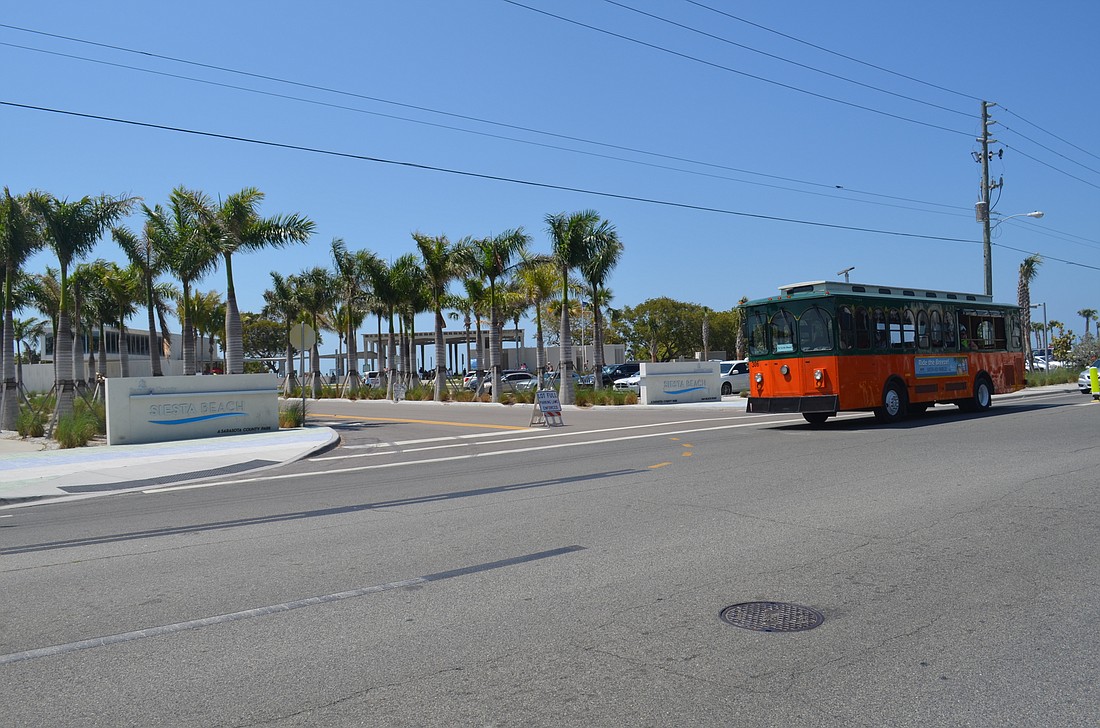- November 28, 2024
-
-
Loading

Loading

Not satisfied with the state and county’s plans for a free shuttle bus route from downtown to St. Armands Circle, the City Commission voted Monday to pursue plans for an enhanced and expanded transit service to the barrier islands.
The commission unanimously agreed to put out a request for proposals in hopes of finding a transportation company to operate an open-air trolley linking Main Street to Lido Key. The board did not finalize details regarding the trolley service, but under the most robust plan the commission discussed Monday, the route could run seven days a week between Main Street east of U.S. 301 and Ted Sperling Park at South Lido Beach.
Launching the trolley service could cost the city hundreds of thousands of dollars, according to estimates city staff produced. That expense is reflective of the commission’s desire to go above and beyond the initial plans the Florida Department of Transportation and Sarasota County Area Transit developed for a bus service between downtown and the barrier islands.
FDOT provided a $1.5 million grant to cover three years of a free bus route running from the downtown SCAT transfer station to St. Armands Circle. The service was designed in response to anticipated traffic congestion associated with the construction of a roundabout at U.S. 41 and Gulfstream Avenue.
Under the initial plan, a single bus would run on a loop, serving each stop on the route every 30 minutes. The service would run from 7 a.m. to 10 p.m. Monday through Saturday beginning in July. The only expenses the city would incur involved marketing, buying signal prioritization equipment and wrapping the buses with a design to look like a trolley. Staff estimated the city’s costs at about $40,000 under that plan.
At Monday’s meeting, staff presented a menu of options for enhancing the service. The potential changes included adding additional vehicles to reduce wait times, expanding the service to Sundays, providing late-night operations, extending the route to Lido Key and using open-air trolley vehicles instead of SCAT buses.
Mayor Hagen Brody has been a vocal advocate for creating a trolley service between downtown and the barrier islands. He said he believed a trolley would attract higher ridership numbers than a bus route would, and he wanted to pursue a more expansive route that could allow users to travel between the east and west ends of downtown in addition to riding out to St. Armands or Lido. Brody expressed hope the trolley could be beneficial for tourists, residents, businesses and more.
“I think this is a huge economic development tool,” Brody said.
Although the FDOT grant could be used to fund a trolley service rather than the planned bus route, the city would still be responsible for covering any additional costs above $500,000 annually. According to staff estimates, the additional expense of running a service with three trolley vehicles from Thursday through Sunday is between $210,000 and $515,000 annually. Commissioner Liz Alpert said she felt it was important to offer the service Monday through Wednesday as well, stating traffic congestion is a problem during rush hour on weekdays.
Brody suggested the city could look to organizations including the St. Armands Business Improvement District and the Downtown Improvement District to assist with funding.
Commissioner Jen Ahearn-Koch was the lone board member to express her preference for a modified version of the original plan. Staff said the process of finding a private operator for the trolley service would likely take four months, pushing the launch date of the new route beyond July. Ahearn-Koch suggested opting for the bus service would allow the program to begin sooner while giving the city more time to explore its budgetary capacity to enhance the transportation line.
“I think it’s more important to start this and then eventually move into the trolley situation,” Ahearn-Koch said.
The rest of the commission was supportive of the open-air trolleys. Staff said details regarding the trolley service, including a finalized route and hours of operation, could be sorted out in negotiations once the city selects an operator.
Planning Director Steve Cover said that even after the route begins operations, the city would have the ability to make revisions to the service based on how the public uses it.
“As time goes on, and we run the system — if there are weaknesses or times that aren’t productive, we can adjust on the go,” Cover said.